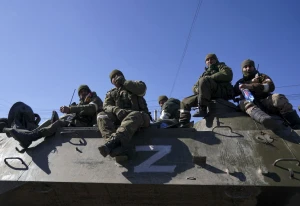
November 20-27 live war map: Russia advances across multiple fronts while Ukraine suffers record territorial losses
Weekly battles have increased from 900 to over 1,000, with Russia capturing nearly 100 square kilometers, primarily in the Berdyansk, Kurakhove, and Pokrovsk areas, as its operations intensify along the southern front
Breakthrough to Velyka Novosilka
The situation near Velyka Novosilka, one of Ukraine's largest fortifications on the southern front, has significantly worsened. While Ukrainian forces have managed to hold the invading Russian troops at their previous positions on the western and southern flanks, there has been a setback on the eastern front. Advancing along the road from Zolota Nyva, Russian forces managed to cover more than 10 km in just five days with almost no resistance, approaching the outskirts of Velyka Novosilka.
This occurred despite the fact that their route passed along a ridge between the Kashlahach and Shaitanka rivers, which could have been easily targeted. However, it seems that the Ukrainian Defense Forces lacked the means or opportunity to stop them. A similar situation unfolded on the road from Shakhtarsk, where Russian forces also advanced more than 10 km and reached Ukrainian fortifications. Meanwhile, advanced Russian units have already attempted to enter the settlement. It is likely that a strong defense will be organized within Velyka Novosilka itself. However, to weaken its resistance, Russian forces are attempting to bypass the settlement from the north. They have already captured half of Rozdolne and are likely to continue moving toward the Velyka Novosilka–Kurakhove road. This would significantly complicate logistics to the settlement and undermine its defensive capabilities.
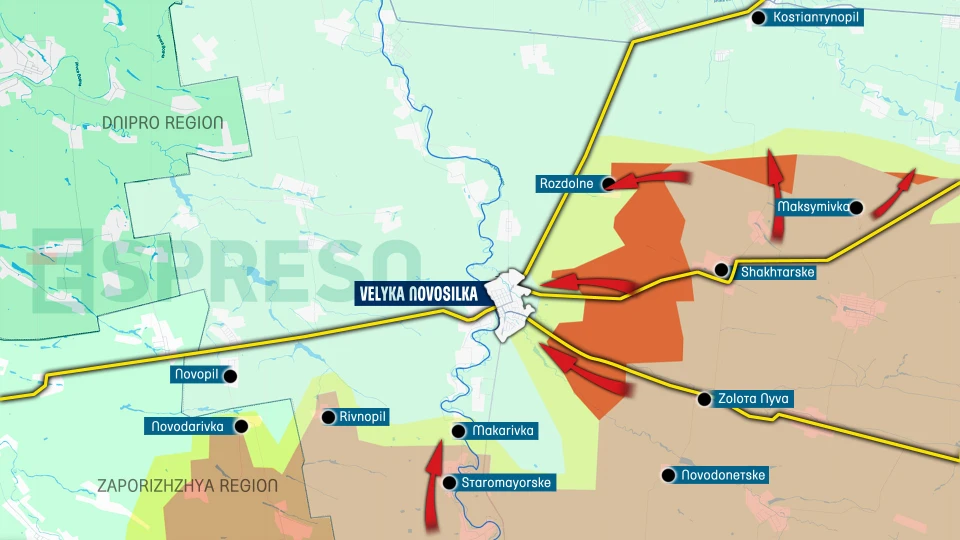
As Russian forces advance from the east, they have also intensified their actions from the south. Here, their goal is not only to quickly recapture the territory that the Ukrainian Armed Forces liberated during last year’s counteroffensive but also to create conditions for a further offensive in the Zaporizhzhia region, particularly around the neighboring front near Huliaipole.
Ukrainian Armed Forces gradually withdraw near Kurakhove
The situation both to the north and south of Kurakhove has been increasingly threatening for the city's defense since the beginning of October. However, over the past two months, the Ukrainian Defense Forces have managed to hold the Russians back, engaging in defensive and rearguard battles, and buying time for their country, often at the cost of their own lives.
Currently, in some areas of the front, the situation is so dire that the Ukrainian Armed Forces are prioritizing a safe retreat over defense. In particular, on the southern flank, Russian troops have advanced 5 km toward Romanivka, cutting off Ukrainian forces defending Antonivka, Illinka, and Yelyzavetivka. Stabilizing the front here seems unlikely, as on the opposite side, the occupiers are assaulting Trudove and Uspenivka, aiming to collapse the line further by 35–40 km². For now, the military is managing to halt the Russians long enough to allow a relatively safe retreat for the forces trapped in a semi-encirclement. Uspenivka and Kostiantynopil are expected to become key strongholds in the near future, holding off the Russian invaders while a new defensive line is being constructed somewhere west of Kurakhove.
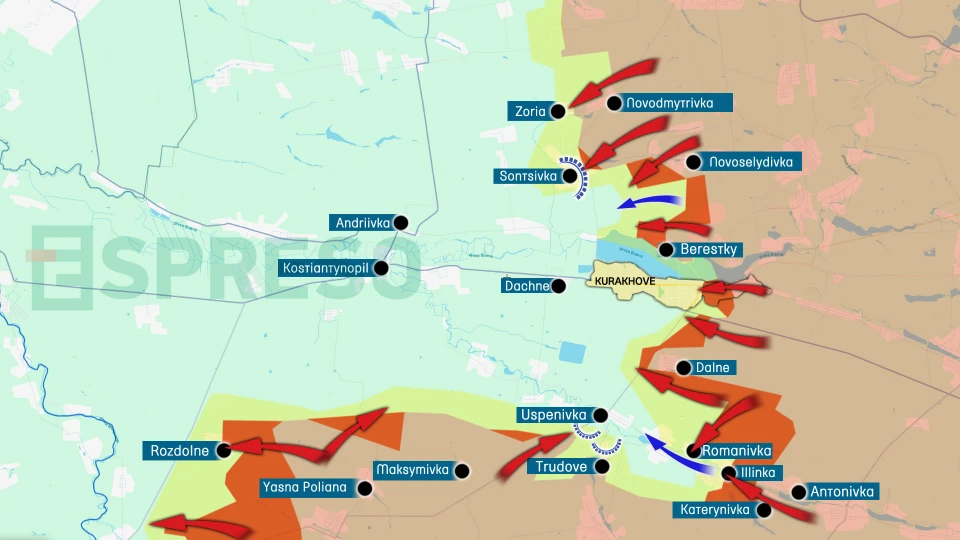
Meanwhile, within the city itself, the Russians have taken control of its entire eastern part. Their assault groups are crossing the ravine and attempting to break through to the central part of Kurakhove to establish positions in the high-rise buildings. The Ukrainian Defense Forces are currently eliminating all those attempting to reach the center. However, the enemy's numbers are soon expected to become overwhelming, and the Ukrainian army will likely be forced to retreat. According to Commander-in-Chief Syrskyi, Russian forces outnumber Ukrainian troops in this section of the front by a ratio of 5:1. For the same reasons, it has not been possible to halt the Russians near Dachne, where their advance threatens both the southern outskirts of Kurakhove and the defenders in the Uspenivka area.
On the northern flank, the Russians have completely occupied Berestky and made a several-kilometer breakthrough southward from Voznesenka. In Sontsivka, Ukrainian defenders held off the Russians for weeks and even attempted counteroffensives. The defense line now runs along the Solona River. From Berestky, the Ukrainian Armed Forces are retreating toward Stari Terny, where they aim to slow the occupiers long-term between the Solona and Vovcha rivers. The duration of the defensive battles here will determine how long Kurakhove can continue to hold. In any case, the Russians have failed to capture the city quickly as they had planned, and its defense is expected to continue into December.
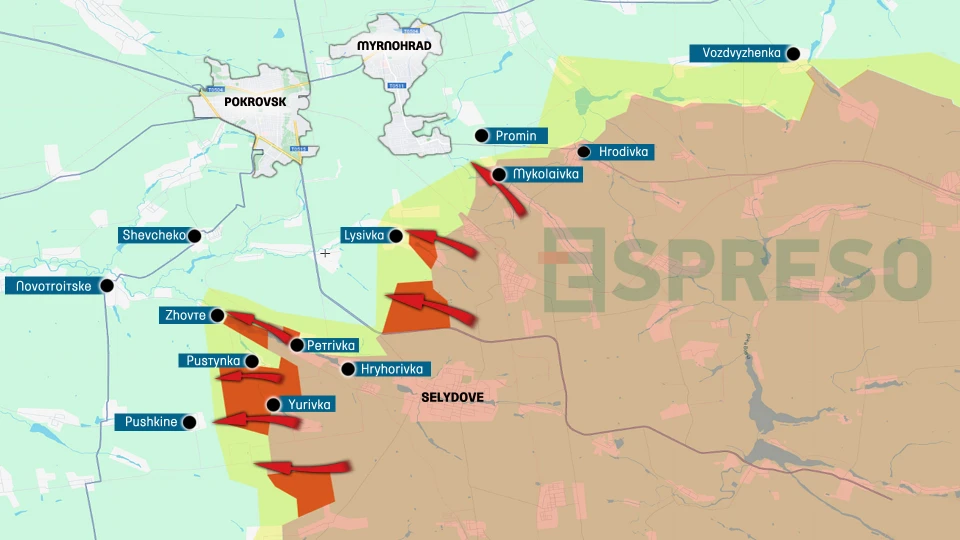
Russians form southern claw on Pokrovsk front
The Pokrovsk front has become increasingly active, with over 300 attacks in the last seven days, surpassing previous records. While the northern flank remains moderately active with no significant territorial changes, the Russians are focusing their efforts on encircling the city from the south, forming what is known as a strike pincer. Key targets in this maneuver are the villages of Novotroitske and Shevchenkove, which would allow the Russians to begin bypassing the city from the south. However, this prospect is not imminent. For now, Russian troops have advanced two kilometers along the Solona River toward the village of Zhovte, where fighting is currently ongoing. They have also expanded their control around the already occupied Yurivka, gradually advancing westward along a 10-kilometer front. Despite their efforts, progress remains slow. The Ukrainian Armed Forces are actively working to stabilize the front, engaging in fierce battles for every stronghold.
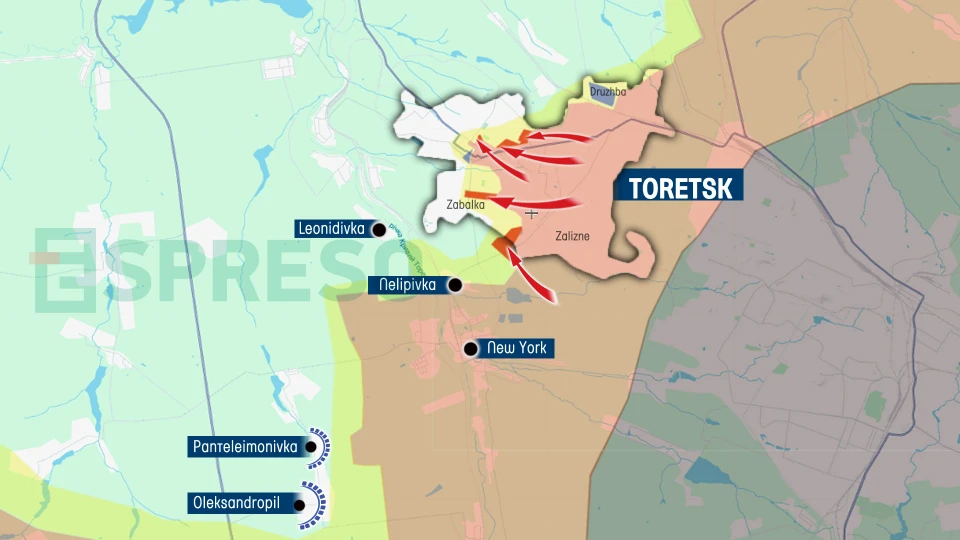
Toretsk swing
The fiercest battles are taking place in the southern part of Toretsk, known as Zabalka. Several weeks ago, the Ukrainian Armed Forces counterattacked and liberated the entire district. However, this week, the Russians resumed their assault, capturing the central part and cutting off Central Street, a vital supply route for the defenders of Nelipivka. Another direction of their advance involves bypassing Zabalka from the south, near Zalizne, with the aim of segmenting the front line and severing the southern edge.
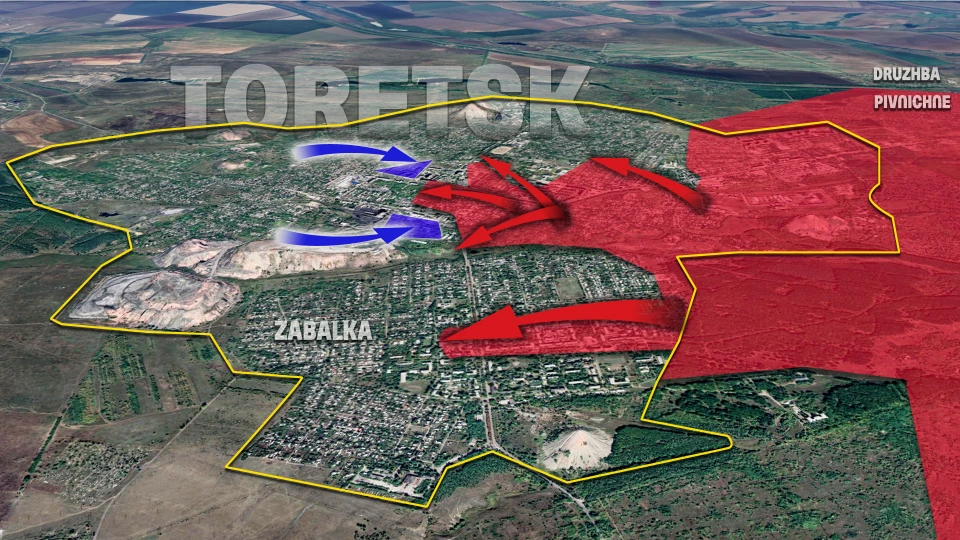
Chasiv Yar - not a step back
Fierce fighting continues in the central part of Chasiv Yar, particularly around the fire-resistant plant. The 24th Brigade, which is defending the city, reports that despite the Russian troops establishing positions in several areas, no armored vehicle has yet managed to cross the canal, and assault groups within the city are gradually being neutralized.
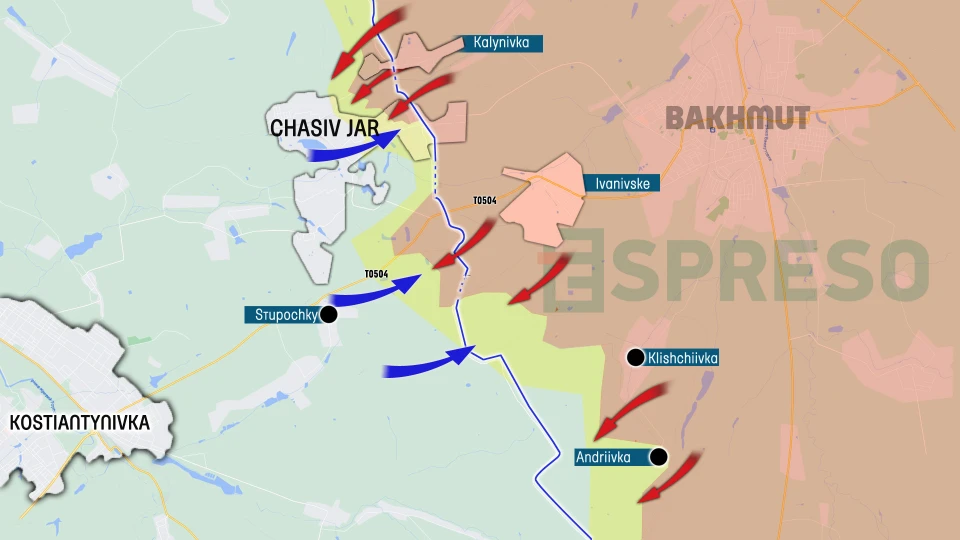
With limited success in the city itself, the Russians are focusing their attacks primarily on the southern flank, where they made advances last week. The gray zone between Klishchiivka and Andriivka is rapidly expanding, with the Russians storming the canal in an effort to cross it. Their aim is to create a southern pincer to bypass Chasiv Yar, advance toward Kostiantynivka, and potentially strike Toretsk from the north.
Eastern front in the Kharkiv region: Kupyansk and Borova
The invaders continue to tighten their grip on the Ukrainian foothold east of Borova. Notably, they have seized several square kilometers of territory between Stelmakhivka and Lozova, pushing beyond the Luhansk region. They are also attempting to bypass Lozova from the south. Additionally, the Russians have made progress southward in Kruhliakivka. One of the most contested areas has been Pervomaiske, which the Russian invaders captured a few weeks ago. However, while they attempted to advance south toward Kopanky, the Ukrainian Defense Forces repelled all assaults and pushed the occupiers back.
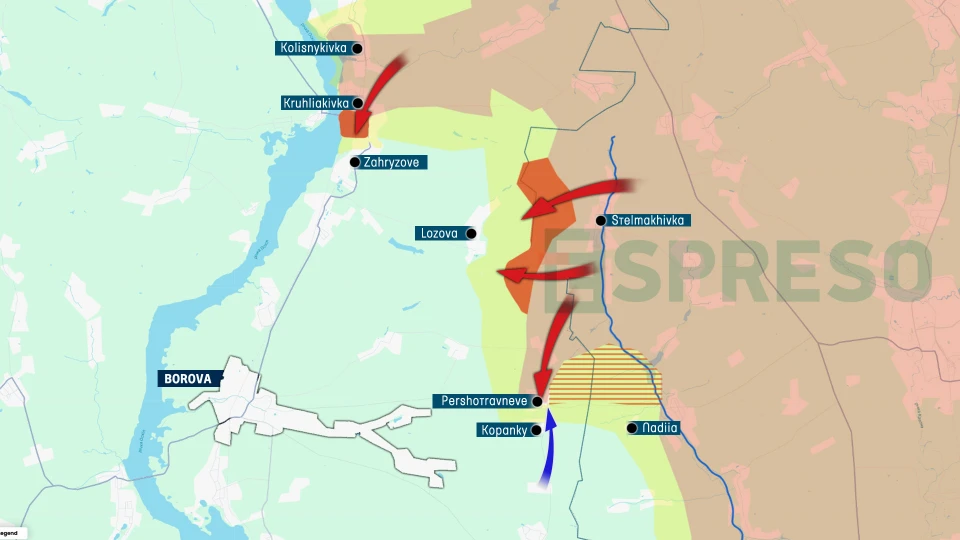
On the northern front, in the Kupyansk area, there have been no changes in the front line, and the Ukrainian Armed Forces have successfully completed the clearance of Kupyansk, where Russian paratroopers had broken through last week.
A surprising development for Ukrainian defenders has been the Russian crossing of the Oskil River to the north of Kupyansk, where the front line had remained stable since 2022. In the area between Novomlynsk and Dvorichne, the Russians managed to penetrate Ukrainian positions and are now attempting to secure and advance toward Novomlynsk. Fighting in the area continues.
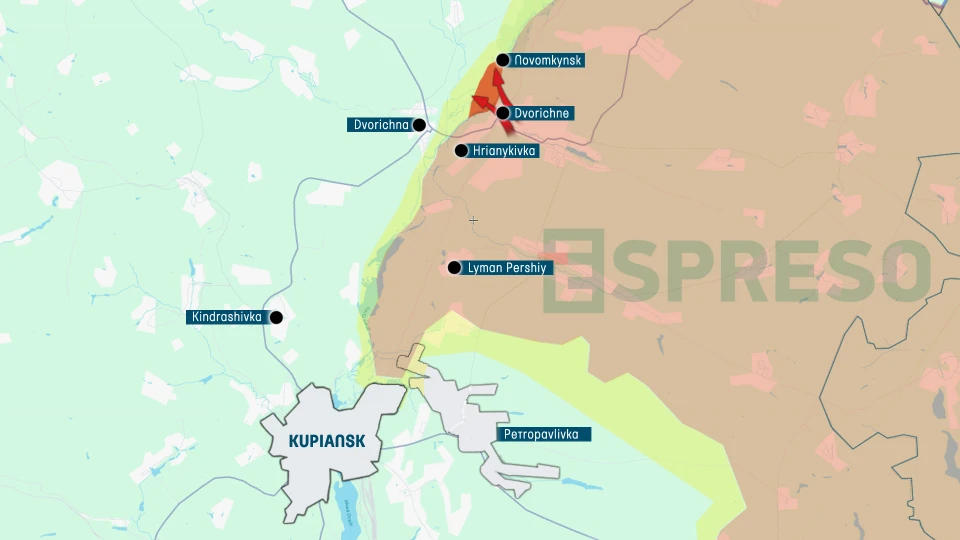
Kursk region in Storm Shadow's crosshairs
Despite Russian forces applying tremendous pressure on the Kursk region, they have achieved no success; on the contrary, all their attacks are being repelled by Ukrainian defenses. The Ukrainian forces have managed to stabilize the front line, even though this was not initially planned, as they had been engaging in operations to expand gray zones. However, after the Russians gathered a force of 50,000 and launched their offensive, the Defense Forces were compelled to retreat from these gray zones, consolidating the front line into a 100-kilometer stretch. In this sector, the Russian troop density is 500 soldiers per square kilometer—comparable to the concentration observed in the Kurakhove direction, where, according to the Ukrainian General Staff, Russian forces outnumber Ukrainian ones five to one. Unlike the Kurakhove front, however, the Ukrainian Armed Forces in Kursk are acting in a highly coordinated manner, successfully repelling enemy advances. A notable example is the destruction of the Russian offensive near Plekhovo, where enemy forces were lured into a fire trap.
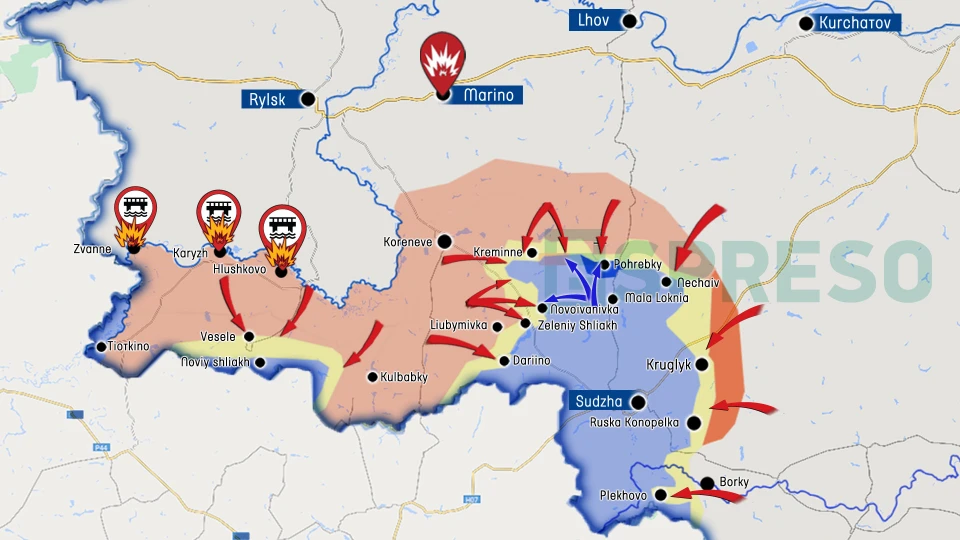
The ongoing fighting in the Kursk region and the setbacks near Kurakhove have once again underscored the urgent need for reforms within the Ukrainian Armed Forces and the transition to a corps-based structure for the Defense Forces.
Meanwhile, six Ukrainian Storm Shadow missiles struck deep into Russian territory, hitting significant targets in Maryino, where a Russian command post overseeing operations in Kursk was located. Dozens of officers were killed, including North Korean personnel. Following the first salvo, a second strike targeted the Kursk airfield, destroying local air defense systems.
The maps were created based on information received from the Ukrainian Armed Forces' General Staff and other open and verified sources. At the same time, the maps are not as accurate as possible and only conditionally reflect trends in the combat zone.
- News








